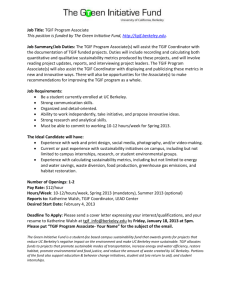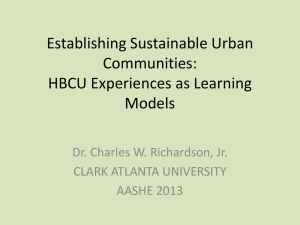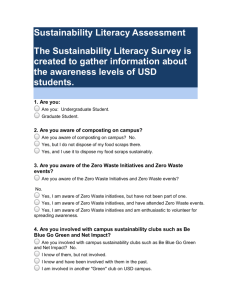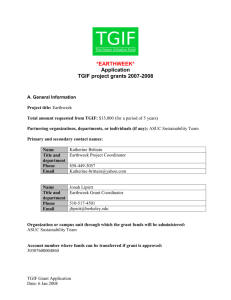2008 Application Submission
advertisement
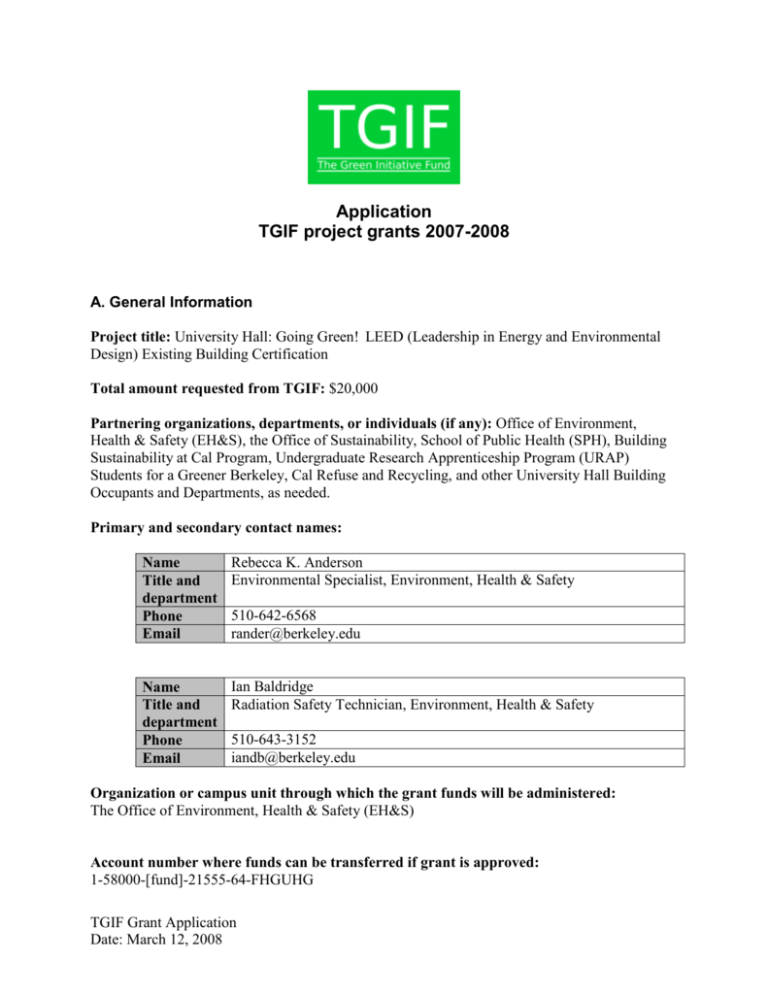
Application TGIF project grants 2007-2008 A. General Information Project title: University Hall: Going Green! LEED (Leadership in Energy and Environmental Design) Existing Building Certification Total amount requested from TGIF: $20,000 Partnering organizations, departments, or individuals (if any): Office of Environment, Health & Safety (EH&S), the Office of Sustainability, School of Public Health (SPH), Building Sustainability at Cal Program, Undergraduate Research Apprenticeship Program (URAP) Students for a Greener Berkeley, Cal Refuse and Recycling, and other University Hall Building Occupants and Departments, as needed. Primary and secondary contact names: Name Title and department Phone Email Rebecca K. Anderson Environmental Specialist, Environment, Health & Safety Name Title and department Phone Email Ian Baldridge Radiation Safety Technician, Environment, Health & Safety 510-642-6568 rander@berkeley.edu 510-643-3152 iandb@berkeley.edu Organization or campus unit through which the grant funds will be administered: The Office of Environment, Health & Safety (EH&S) Account number where funds can be transferred if grant is approved: 1-58000-[fund]-21555-64-FHGUHG TGIF Grant Application Date: March 12, 2008 B. Project Description (The maximum total length for answers to all questions in this section is 300 words.) 1. Purpose Describe the overall purpose of your project and its key components. Together, the occupants of University Hall have begun an initiative to Go Green! with LEED – Existing Building certification as the end goal. Key components of this grant will help to achieve the following LEED credits: Energy & Atmosphere: optimize energy performance (2 pts) o Replace inefficient appliances with energy efficient models (e.g. Energy-star) Materials & Resources: solid waste management (1 pt) o Implement composting program Indoor Environmental Quality: entryway systems (1 pt) o Implement entryway system for particle control Innovation in Operations: communication, education (1 pt) o Student internship o Work with Building Sustainability at Cal classes o Develop Outreach and Education Program o Document efforts through case study 2. Sustainability Goals Which aspects of campus sustainability will your project address, and why is addressing these sustainability components important? This project will initiate sustainable measures in building operations. Addressing this area of campus sustainability is vitally important to achieving campus goals, as building operations are responsible for a large percentage of the campus footprint. For example, existing building operations account for 39% of the nation’s CO2 emissions (average, United States Green Building Council). Does your project tie into any broader campus sustainability initiatives? If so, how? (For example, CalCAP, activities by CACS, etc.) This project directly ties into several campus initiatives, including: Initiative CalCAP Building Sustainability at Cal CACS Green Building Initiatives TGIF Grant Application Date: March 12, 2008 Project Contribution Reduce University Hall’s carbon footprint by using student and staff effort to integrate sustainable practices into building operations, and then communicating that effort as a model for other campus buildings in developing sustainable operations. 3. Project Benefits How will this project benefit your fellow students? How will your project benefit UC Berkeley as a whole? -Provides a unique student learning opportunity to apply in a real-life situation -Visitor’s Center: showcase UC Berkeley as a Green Campus -Model for LEED existing building projects on campus -Model for other academic institutions and buildings -Helps meet UCOP Green Building Initiatives -Will enable the campus to meet LEED-EBOM standards 4. Approvals for Project Activities Do any aspects of your project require approval from an entity on or off campus? If so, please explain. (For example, any project which affects a campus building must be approved by the appropriate campus facilities personnel.) The building manager of University Hall has approved and supported all aspects of this proposal. What is the status of these approvals, as of the date you’re submitting this proposal? Project has been approved, but may require minor approvals from building department heads. C. Project Goals and Quantifiable Impacts (The maximum total length for answers to all questions in this section is 300 words.) 1. Metrics and Measurability What quantifiable sustainability impacts will your project have? (This might be kWh of electricity saved, gallons of water saved, tons of carbon emissions avoided, specific area of land preserved, etc.) 1. Kilowatt-hour electricity saved 2. Pounds organic material diverted from landfill 3. Indoor air quality improvement (Numbered items in questions below correspond to the above metrics) How will you measure these impacts after your project is implemented in order to see if you met your goal? 1. Watt-Meter will measure performance of old and new appliances. 2. Composting will be weighed to determine lbs of diversion. 3. Before and after the new entryway floor mats are replaced, a TSI Dustrak will determine amount of airborne particle reduction. TGIF Grant Application Date: March 12, 2008 How do these impacts fit into the larger campus context? (For example, what fraction of campus electricity use does your savings represent?) The above measures are innovative strategies to attack “low-hanging fruit” and by using them as concrete examples they can serve as catalysts for a net impact on the campus. 2. Additionality or Marginal Benefit If your project involves doing something that UC Berkeley does anyway (meeting minimal green building standards or basic environmental regulations), how does your project go above and beyond these minimal requirements? Currently, the Policy on Sustainable Practices outlines a number of green building requirements. Please reference table below for details of how project exceeds requirements. Requirement University will develop a plan to operate and maintain buildings at the LEED-EB certified level. University will purchase Energy Star products when available (new purchases). The University adopts a waste diversion goal of 50% by 6/2008 and 75% by 6/2012. University will explore ways to connect LEED buildings with education & research mission. Exceeded by This project strives for LEED – Silver rating. This project seeks to proactively replace outdated equipment with energy efficient models. This project goes above and beyond the required diversion rate. This project directly involves academic classes, student volunteers and a student intern. The project also serves as an educational opportunity for the university, community and campus visitors. 3. Cost Savings and Repayment to the Fund If your project will generate costs savings to the University, please estimate them here. This project will generate a cost savings of approximately $700 per year. Education of building occupants will further reduce energy and save money (quantified later). Using the PG&E Home Appliance Calculator, it was found that $1456.35 is currently spent per year in electricity costs for our refrigerators. By implementing energy efficient models, we will lower the total cost to $766.50 per year. Will any of the savings be available to pay back into TGIF? No, but energy use reductions will result in savings to allow for future Sustainability projects. TGIF Grant Application Date: March 12, 2008 D. Project Team 1. Project team members Please fill in a table like the one below for each team member. Three blank tables have been provided for you. You may copy and paste a blank table to create additional entries for project teams larger than three. Name Title and department Address Phone Email Relevant experience or knowledge for this project Hours per week for this project Name Title and department Address Phone Email Relevant experience or knowledge for this project Hours per week for this project Rebecca K Anderson Environmental Specialist, Environment, Health & Safety 317 University Hall, #1150 510-642-6568 rander@berkeley.edu Has worked in environmental arena for five years, specifically in the area of sustainable building operations for three years. Attended LEED for Existing Building training in 2007 and is working toward LEED accreditation. Completed Introduction to Project Management class through UC Berkeley extension. Eight Ian Baldridge Environmental Specialist, Environment, Health & Safety 317 University Hall, #1150 510-643-3152 iandb@berkeley.edu Involved in community sustainability and most recently serves as the chair to the Environment, Health & Safety Sustainability Committee (2007present). Four or as needed. TGIF Grant Application Date: March 12, 2008 Name Title and department Address Phone Email Relevant experience or knowledge for this project Hours per week for this project Name Title and department Address Phone Email Relevant experience or knowledge for this project Hours per week for this project Name Title and department Address Phone Email Relevant experience or knowledge for this project Hours per week for this project Kelley Etherington Hazardous Materials Specialist, Environment, Health & Safety 317 University Hall, #1150 510-643-7195 Kelley_e@berkeley.edu I have twenty years of experience in the environmental field, 7 years at UC Berkeley. I successfully managed a three-year EPA mercury reduction grant for EH&S as well as a dozen (or so) other grants to reduce oil pollution. I attended a LEED –NC class about 2 years ago due to my interest in Green Buildings. Member of EH&S Sustainability Committee. Four Sara Souza Research Safety Specialist, Environment, Health & Safety 317 University Hall, #1150 510-643-5809 sarasouza@berkely.edu Graduate of Environmental Sciences and School of Public Health programs; member of EH&S Sustainability Committee; trained industrial hygienist, will perform indoor air quality monitoring; Registered Environmental Health Specialist, will monitor and promote sanitation of compost bins Two or as needed Greg Van Aken Deputy Fire Marshal 317 University Hall, #1150 510-643-8373 gvanaken@berkeley.edu 15 years of experience in project management. Working toward LEED Accreditation. Took LEED accreditation class with ROLF Jensen & Associates. Member of EH&S Sustainability Committee. Two or as needed TGIF Grant Application Date: March 12, 2008 Name Title and department Address Phone Email Relevant experience or knowledge for this project Hours per week for this project Donna Reese Editing Assistant, Environment Health & Safety Name Title and department Address Phone Email Relevant experience or knowledge for this project Hours per week for this project Cheryl Reinman Web Manager, Environment Health & Safety Name Title and department Address Phone Email Relevant experience or knowledge for this project Hours per week for this project Steve Maranzana Assistant Manager, Training, Emergency Response & Audit 317 University Hall, #1150 510-642-1550 dreese@berkeley.edu Experience in facilitating and organizing meetings and events. Involved in community sustainability. Member of EH&S Sustainability Committee. Two or as needed 317 University Hall, #1150 510-642-1978 tortuga@berkeley.edu Environmental Science, BA. Assisted with EH&S student run class for 7 years, teaching basics of environment, health and safety. Web design and development skills. Member of EH&S Sustainability Committee. Two-Four 317 University Hall, #1150 510-643-1208 stevemar@berkeley.edu Undergraduate degree from UC Berkeley in Environmental Science. Masters of Science from University of San Francisco in Environmental Management. Worked as an Environmental Specialist at UC Berkeley, EH&S for 8 years. Member of EH&S Sustainability Committee. Two or as needed TGIF Grant Application Date: March 12, 2008 Name Title and department Address Phone Email Relevant experience or knowledge for this project Hours per week for this project Janis Honda Building Manager, University Hall 50 University Hall, #7360 510-643-6954 jkhonda@berkeley.edu Building coordinator, facilities manager for over 20 years at UC Berkeley SPH; multiple building and surge projects, renovation projects, knowledge of campus design, maintenance systems; current POC for all sustainability activities at SPH and collaborative sustainability groups Five or as needed 2. Additional Team Info If your project team is partnering with other organizations, departments, individuals, or other stakeholders, please explain their involvement. (100 words max) The SPH and Office of Sustainability will serve as advisors to this project as well as assist in outreach to University Hall occupants. Students in the Building Sustainability at Cal program will be responsible for: Outreach to University Hall occupants Identification of future compost bin locations Identification of appliances for replacement A student intern will be responsible for: Creation of outreach materials (signage, pamphlets, presentation) Integration with visitor’s center campus tour Assistance in setting up composting program Which person or persons on your team is ultimately accountable for ensuring that the project succeeds? (i.e., who is the project manager?) Rebecca Anderson will be serving as project manager with Ian Baldridge as secondary. TGIF Grant Application Date: March 12, 2008 Which person or persons will be responsible for reporting project status and accomplishments back to TGIF? (For example, if your project goal is to save a certain amount of fuel each year, who will measure the savings and report the number to TGIF each year?) Rebecca Anderson Please be specific about the ways in which you can ensure that your team will have this time available. (For example, students might choose to take fewer classes in order to have time to devote to the project. Staff might receive permission from a supervisor to devote X hours per week to the project.) (50 words max) Rebecca Anderson and Ian Baldridge have been allotted time from respective managers to devote significant effort to the project. EH&S Sustainability Committee members have been granted time by EH&S senior management for assistance in project implementation. Students will be involved through the Building Sustainability at Cal Program and paid internships. 3. Student Involvement Will your project involve students other than those listed on this application? (For example, a project might involve recruiting student volunteers or hiring student interns.) Yes. If so, how many students? What kind of students? How will they be involved? (100 words max) Undergraduate students in Building Sustainability at Cal courses will be involved in project analysis and implementation, with 4-20 students involved in this manner. At least one additional student will serve as a paid intern to help implement and document project success. Students from URAP will be involved in a project that would include the following elements: - Developing a case study of University Hall - Examining metrics of projects, compare to other documented cases - Research suggestions for continued improvement - Research how University Hall can serve as a model for buildings on campus - Other items as interest warrants E. Project Education, Outreach, and Publicity Plan Note: This section is about letting the campus know what your project has accomplished after you’ve met your project goals. If outreach and education are actually the primary goals of your project, please describe them above in the section entitled “Project Goals and Quantifiable Impacts.” (The maximum total length for answers to all questions in this section is 100 words.) What is your plan for letting others on campus know what your project has accomplished? TGIF Grant Application Date: March 12, 2008 A case study will be available online and through presentation (CACS, PP-CS Staff, etc.). Also promotion of project communication includes: marketing material in University Hall lobby (kiosk, pamphlets, signage, etc), Visitor’s Center Campus Tour integration, and Building Sustainability at Cal course involvement. Berkeleyan article, DSC network presentations. Do you have any specific outreach goals? If so, how will they be measured? (For example, number of students attending info session, number of hits on informational website, etc.) Outreach Goal Building Sustainability at Cal involvement Visitor’s Center Campus Tour integration Case Study Online Posting Presentations Bulletin Board, pamphlets and signage TGIF Grant Application Date: March 12, 2008 Measurement Number of participating students Direct feedback Number of requests/downloads Number of downloads Number of presentations given, evaluation sheets Direct observance, number pamphlets taken F. Project Budget 1. Budget Table List all budget items for which funding is being requested. Include cost and total amount for each item requested. (Insert additional rows if necessary.) Item ENERGY EFFICIENCY RETROFITS Replacement & installation of appliances (mainly refrigerators) with more efficient models (ex. energy star). Also includes cost estimate for removal of old appliances. SOLID WASTE MANAGEMENT Initial start up cost for composting in all break rooms (containers & signage) GREEN CLEANING Entryway system (Floor Mats) to reduce the amount of particles entering the building, to be placed at 3 main entrances COMMUNICATION – Total $3000 Development of project logo Signage for green projects Pamphlets for visitors Kiosk for “Sustainable News!”, case study, etc. in entryway STUDENT INVOLVEMENT One student intern for period of 3 months to assist in project implementation Cost Request $10,000 $10,000 $1,250 $1,250 $1,500 $1,500 $150 $300 $1700 $850 $150 $300 $1700 $850 $4,250 $4,250 Total $20,000 2. Continuing Support If you are funded, will your project need any on-going funding after the completion of this grant? What is your strategy for supporting the project after this initial period to cover replacement, operational, and renewal costs? (Note that TGIF is unlikely to provide funding beyond the initial year for ongoing projects.) Minimal ongoing funding will be needed for the composting component of this project. Departments in University Hall have pledged money to support this ongoing cost, as well as volunteer time and effort in maintaining the program. 3. Other sources for funding and in-kind resources Please describe any non-TGIF sources you are pursuing for funding, volunteer time, inkind donations, etc. Non-TGIF Sources: staff volunteer time TGIF Grant Application Date: March 12, 2008 G. Project Timeline Please complete the following table to describe your project timeline. List milestones chronologically. (Insert additional rows if necessary.) Make sure to include estimates for: Project start date Target date for project completion Date by which you will need the first installment of TGIF money Date by which you expect to have spent all TGIF funds Target date for submitting final project report to TGIF Any significant milestones along the way Milestone Project start o Kick-off meeting with project team o Announcement email to partnering organizations o Meet with LEED Project Team to announce TGIF project start Begin implementation of URAP Project o Work with Prof. Bill Berry on logistics (see student involvement section) Student internship o Advertise for student internship o Hire student intern* Begin plan for composting program o Gather information and best practices on composting collection (RSSP, UCOP, etc.) o Examine trash audit (to be conducted Spring 2008) to determine amount of ongoing consumables currently in trash o Meet with Refuse & Recycling Services o Tour University Hall to determine locations of bins o Design signage for composting bins o Plan how compost collection will work Audit inefficient appliances o Conduct audit to determine type, number and location of inefficient appliances o Identify energy efficient (energy star) replacements o Track current energy use of representative inefficient appliances with Watt-meter o Determine end home for inefficient appliances after they are replaced (Excess & Salvage, recycling, etc.) Communication & education o Integrate into Building Sustainability at Cal courses o Research kiosk for purchase TGIF Grant Application Date: March 12, 2008 Estimated completion date Week 1 Week 2 Week 4 Week 4 Week 6 Week 10 o Develop project logo* o Develop signage for green projects o Create pamphlets for visitors Milestone Identify entryway system for particle control o Research entryway systems for each entry o Work with custodial staff to integrate entryway systems into cleaning schedule o Conduct particle count study of current system Implement entryway system for particle control o Purchase and install entryway systems* o Conduct particle count study of current system Replace inefficient appliances o Purchase efficient appliance replacements* o Install new appliances and “recycle” old appliances* o Track new energy use of representative replacement appliances with Watt-meter Implement composting program o Purchase composting bins* o Install composting bins o Train users on composting (ex. Department presentations, email to building, signage, etc.) o Track composting progress/success Communication & education o Print Pamphlets and Signage* o Integrate into Visitor’s Center Campus Tour o Write case study o Post case study and other information online o Conduct presentations o Purchase kiosk for “Sustainable News!”, case study, etc.* Estimated completion date Week 10 Week 13 Week 16 Week 18 Week 25 Other notes on project timeline (if necessary): Starred Items (*) require funding from TGIF. These items have a flexible schedule based on the release of funds. These items have also been allowed a long lead time for product delivery (e.g. composting bins) Items in the same section (e.g. implement composting program) that are preceded by a starred item are contingent upon that item’s completion before they are started. (e.g. “install new appliances and recycle old appliances” cannot occur before the “purchase of efficient appliance replacements”) All money will be spent by project completion, Week 25 TGIF Grant Application Date: March 12, 2008 H. Help TGIF Improve This Application (optional) Note: All questions in this section are optional. Your answers (or your choice to skip these questions) will have no affect on TGIF’s decision on funding your project. In particular, TGIF will not reward or penalize applicants based on how much time they spent on the application, but it will help us give next year’s applicants an idea of how much work is involved. How can TGIF make this form better for next year’s at-large student applicants? Allow attachment of other documentations (e.g. calculation sheets of cost savings) How many weeks did you and your team work on this application, from the time you started to the time you submitted it? Three weeks About how many hours do you think each student on your project team spent preparing the application (including writing, background research, discussions with campus sponsors, getting approvals, etc.)? Two hours About how many hours do you think each non-student on your project team spent preparing the application? Six – Twenty hours Anything else you want to tell us? Accountability toward sustainability begins with exemplary models communicated through education and outreach. University Hall is ready to commit to establishing first steps toward becoming a proactive model and resource for other buildings and organizations. Including students increases the impact potential on the future. Going green takes some “green” to begin the process. Please consider investing in our commitment. TGIF Grant Application Date: March 12, 2008
